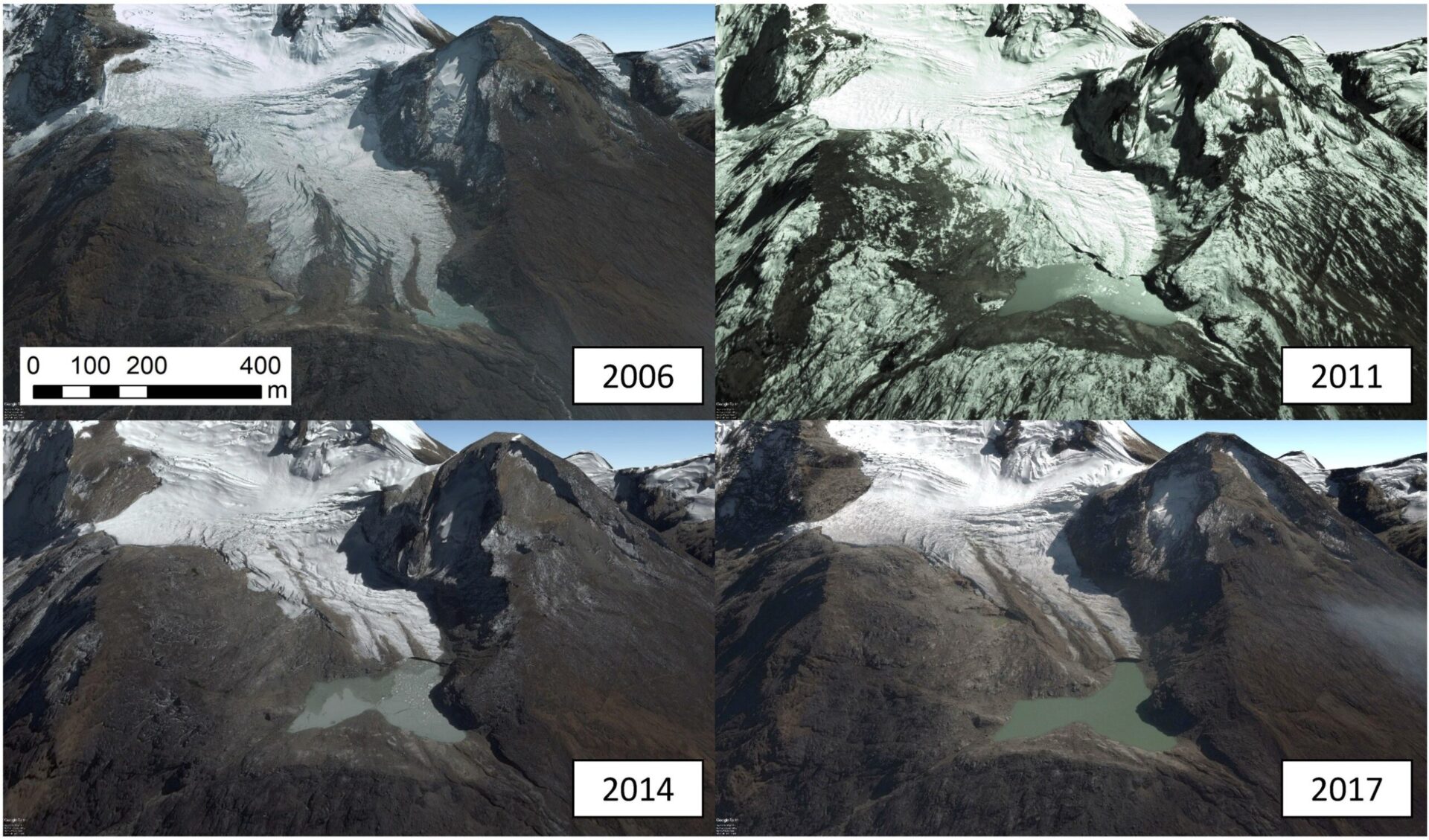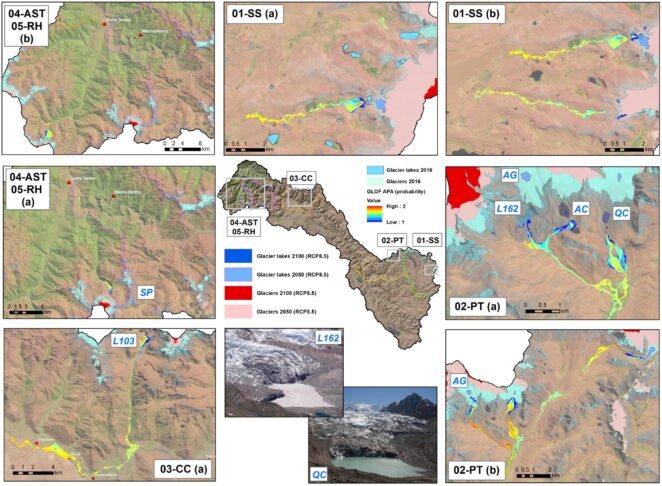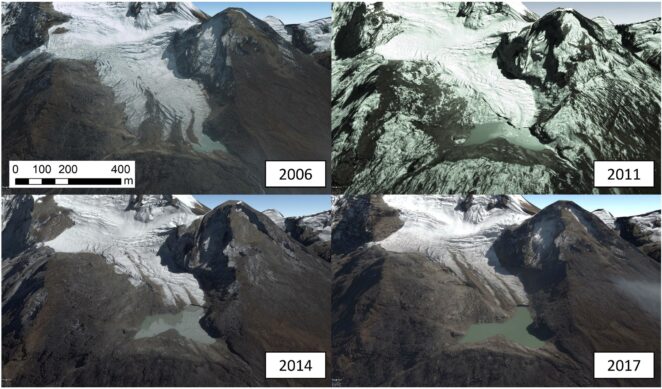Risks and options from new lakes in the Andes of Peru: implications for future water management

Introduction
In the Andes of Peru and adjacent arid lowlands, human subsistence often depends on year-round streamflow from glaciers and lakes, particularly in the dry season. However, global change impacts increasingly affect local hydrology and associated livelihoods which is clearly demonstrated by the impacts of glacier shrinkage. Rapidly growing lakes (Fig. 1) in deglaciating mountain regions potentially imply severe risks but also options for human livelihoods.
On the one hand, seasonal water scarcity and Glacial Lake Outburst Floods (GLOF) pose a serious threat for highly exposed and vulnerable people. In addition, water demand is growing due to increasing irrigated agriculture, population and hydropower production. On the other hand, future lakes bear important options for integrated disaster risk management (IDRM) and for integrated water resources management (IWRM) potentially attenuating deglaciation-driven discharge variability and scarcity. Additionally, new lakes could offer important attractions for tourism.
In this context, a recent study has been published led by University of Zurich in collaboration with CARE Peru within the framework of the ‘Glacier Project+’, an initiative by the Swiss Agency for Development and Cooperation (SDC). This research combines current and future glacier and lake trends with potential water risks and management options in the Vilcanota-Urubamba basin (VUB), Southern Peru. The VUB represents one of the most extensively glaciated areas in the tropical region worldwide and is characterized by traditional livelihoods as well as increasing water demand driven by population growth and urbanization, irrigated agriculture and tourism which also includes the Inca citadel of Machu Picchu.
Fig. 1: Development of the lake A162 (−72.78W, −13.20S, 4573 m asl., Cordillera Vilcabamba) in the period 2006–2017. Imagery: CNES Airbus/Digital Globe (Google Earth), Drenkhan et al. 2019.
Risk potentials: lake outburst floods and water scarcity
The GLOF susceptibility and potential reach of damaging flow of current and future glacier lakes were analysed with the Modified Single-Flow-direction (MSF) model. Eighteen out of 134 current and another six out of 20 future glacier lakes were identified as potentially highly susceptible to GLOF. A total of eight existing and one possible future lakes indicate very high risk potentials.
Furthermore, a comprehensive surface water balance scheme for five selected subcatchments reveals that future river discharge could be reduced by some 2–11% (7–14%) until 2050 (2100). Particularly in headwaters and during dry seasons, glacier contribution representing roughly 15–25% to total streamflow is crucial and would substantially decrease to below 4–22% (1–3%) until 2050 (2100) with strong glacier shrinkage under intense warming (scenario RCP8.5). In the middle and lower basin, long-term water availability could be jeopardized by growing irrigated agriculture and hydropower capacity. Combining a GLOF and water shortage risk assessment, three key hotspots (02-PT, 03-CC and 04-AST – see also Fig. 2) of current and future water risks were identified.
Fig. 2: MSF modelling results for areas potentially affected (APA) under maximum GLOF reach (2–3°) for selected (a) current and (b) future critical lakes in the five selected subcatchments (01-SS=Salcca–Sibinacocha; 02-PT=Pitumarca–Tigre; 03-CC=Ccochoc–Chicón; 04-AST=Aobamba–SantaTeresa; 05-RH=Runtumayu–Hualancay). Selected lakes with (very) high risk are labelled (current lakes: L103, L162, AC= Azulcocha, QC= Qomercocha, SP= Sisaypampa; potential future lake: AG= Ausangate), Drenkhan et al. 2019.

Options for Adaptation to Climate Change and future water management
In the context of shrinking glaciers and growing glacier lakes, several options arise for long-term water management. These include lake damming, ancestral initiatives on small and decentralized water infrastructure and multi-purpose use of water across different sectors (e.g. hydropower, agriculture, households and tourism). This is particularly interesting in the study region where recently a Water Resources Council was established within the framework of the new Water Resources Law in Peru. This new water architecture promotes and intersectoral and sustainable water use coordination among different stakeholders, such as regional and local governments, agricultural users and peasant communities. Therefore, the identification of water risk hotspots and long-term implementation of adaptation measures within a participative process would, thus, represent an important step to mitigate and contain social conflicts over water which have a long-lasting history in Peru and hamper sustainable water management.
Lessons Learnt
- Upstream-downstream relationships are important to consider for the evaluation of risks and potentially affected people under shrinking glaciers and potential reductions in future supply in headwaters as well as domestic, agricultural and hydropower demand increase in the middle and lower catchment
- Glacier contribution to river discharge is particularly important in headwaters and during dry seasons, but is likely to substantially decrease towards the mid-century and become mostly insignificant until the end of this century
- Water demand, an under-researched field in many countries, could outweigh impacts from shrinking glaciers within the next decades, stressing the need for more socioeconomic studies and a stronger focus on more efficient and equitable water use
- Current and potential future natural lakes represent an important component for water resources management but cannot by any means compensate the loss of water reserve due to glacier shrinkage
- Ancestral and local knowledge should play a more visible role in current adaption planning and co-production of knowledge, also in view of water storage as well as allocation options considering current and potential future social conflicts
- Long-term water management planning and implementation should take place beyond temporarily limited governmental and project agency and strengthen broad acceptance of corresponding measures for adapting to hydroclimatic and socioeconomic changes
- Drenkhan, F. (2018): Current And Future Glacier Vanishing And Associated Lake Growth In The Peruvian Andes. Science Trends. https://sciencetrends.com/current-and-future-glacier-vanishing-and-associated-lake-growth-in-the-peruvian-andes/
- Glacier Project (2018): Brief: Modelling future lakes in glaciers beds. 6 pp. Lima, Peru. Online: http://www.proyectoglaciares.pe/wp-content/uploads/2018/06/Brief-Modelling-future-lakes-in-glacier-beds.pdf
- Guardamino, L., Haeberli, W., Muñoz, R., Drenkhan, F., & Cochachin, A. (n.d.). Modelled glacier-bed overdeepenings and possible future lakes in the Cordilleras of Peru.
- SDC’s ‘Glacier Project+’ within the Global Programme ‘Climate Change’: https://www.eda.admin.ch/deza/en/home/themes-sdc/climate-change/sustainable-development-mountain.html/content/dezaprojects/SDC/en/2011/7F07833/phase2?oldPagePath=/content/deza/en/home/themen/klimawandel/berggebiete.html
- Homepage of the Glacier Project+ in Peru (only Spanish): http://www.proyectoglaciares.pe/
- Research group at University of Zurich with short project description: https://eclim-research.ch/glaciares
Suggested citation
Drenkhan, F., Huggel, C., Guardamino, L., & Haeberli, W. (2019). Managing risks and future options from new lakes in the deglaciating Andes of Peru: The example of the Vilcanota-Urubamba basin. Science of the Total Environment, 665, 465–483. https://doi.org/10.1016/j.scitotenv.2019.02.070
Related resources
- SDC Global Brief: Climate Change and Glaciers
- Glaciology Curriculum
- Preparing for glacial lake outbursts in Peru
- PACC Peru Climate Change Adaptation Programme: Strengthening actions, scaling up responses
- Yachaykusun: Lessons on climate change from the Andes
- Climate change adaptation in China: monitoring and early warning of glacial lake outburst floods in the area of Yarkant River

(0) Comments
There is no content